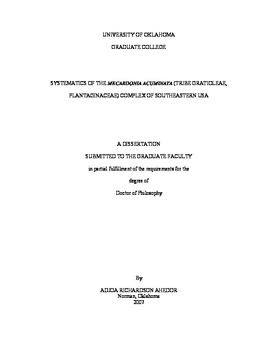| dc.contributor.advisor | Elisens, Wayne J., | en_US |
| dc.contributor.author | Ahedor, Adjoa Richardson. | en_US |
| dc.date.accessioned | 2013-08-16T12:20:39Z | |
| dc.date.available | 2013-08-16T12:20:39Z | |
| dc.date.issued | 2007 | en_US |
| dc.identifier.uri | https://hdl.handle.net/11244/1194 | |
| dc.description.abstract | Seed surface morphology is known to be of taxonomic significance in some plant taxa, and has been used as diagnostic features of some families, genera and species. The tribe Gratioleae (Plantaginaceae) consists of 16 genera with worldwide distribution. Similar seed surface morphologies have been observed in some members of the tribe. This study employed scanning electron microscopy (SEM) to examine detailed seed surface scultpturings of 37 species belonging to eight genera of the tribe. Sixteen seed types were identified and unique to most genera. The overall diversity of seed surface morphology observed in the tribe Gratioleae suggests extensive but taxonomically significant seed morphological variations in the tribe. Three reticulate seed types were identified for the genus Mecardonia that has three species endemic to the USA. Mecardonia acuminata, a widespread species in southeastern USA consists of at least three subspecies (acuminata, peninsularis and microphylla). Inter-simple sequence repeat markers (ISSR) were employed to elucidate the genetic variation of 23 populations in the species complex. Morphological examinations of the individuals sampled across the entire range of the species were also performed to evaluate subspecies diagnostic features and to assess the actual distributional range of each of the subspecies. Analysis of ISSR markers confirmed a widespread distribution of subspecies acuminata and identified populations with high genetic diversities occurring mainly in the southern ranges of the species. The ISSR analysis also revealed some populations of subspecies microphylla that were originally considered to be populations of subspecies acuminate. Morphological analyses also revealed possible broad historical range distributions of subspecies peninsularis and microphylla that occurred throughout most of the range of subspecies acuminata. Clinal variations were also observed in some characters particularly leaf length which was found to increase from south to north across the distributional range. Regional biogeographic analysis of the morphological data revealed separation of individuals endemic to southern Florida. | en_US |
| dc.format.extent | xiv, 141 leaves : | en_US |
| dc.subject | Plants Classification. | en_US |
| dc.subject | Biology, Botany. | en_US |
| dc.subject | Plantaginaceae. | en_US |
| dc.subject | Seeds Morphology. | en_US |
| dc.title | Systematics of the Mecardonia acuminata (tribe Gratioleae, Plantaginaceae) complex of southeastern USA. | en_US |
| dc.type | Thesis | en_US |
| dc.thesis.degree | Ph.D. | en_US |
| dc.thesis.degreeDiscipline | Department of Microbiology and Plant Biology | en_US |
| dc.note | Adviser: Wayne J. Elisens. | en_US |
| dc.note | Source: Dissertation Abstracts International, Volume: 68-04, Section: B, page: 2014. | en_US |
| ou.identifier | (UMI)AAI3261117 | en_US |
| ou.group | College of Arts and Sciences::Department of Microbiology and Plant Biology | |
